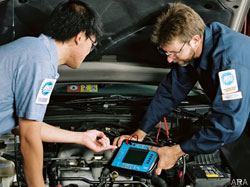(ARA) – In today’s economy, consumers are more cost-conscious than ever. “There are plenty of basic strategies drivers can use to stretch their fuel dollar,” notes Martin Lawson, editorial director for the non-profit National Institute for Automotive Service Excellence.
The following advice is from the pros at ASE, who note that these tips will not only save gasoline, they’ll help extend the life of your vehicle. For more information, including seasonal car care tips, visit www.ase.com.
* Monitor your tires. Under-inflated tires or poorly-aligned wheels waste fuel by forcing the engine to work harder. Let the tires cool down before checking the air pressure. Out-of-line wheels, as evidenced by uneven tread wear, should be aligned by a professional. In addition to saving on gasoline, you will save by not needing to replace tires as often. And fewer tires will need to be scrapped, which is good for the environment.
* Change the way you drive. For example, drive gently — sudden accelerations guzzle gas. Anticipate traffic patterns ahead of time and adjust your speed gradually. Use cruise control. (You’ll help your car’s engine last longer, too.)
* Observe speed limits. Speeding decreases your miles per gallon. As a rule of thumb, mileage begins to decline sharply above 60 mph or so, as air drag puts ever-increasing demands on the engine.
* Avoid excessive engine idling. Shut off your vehicle while waiting for friends and family for more than a minute or so. An idling engine gets 0 mpg.
* Remove excess weight. Store only essentials in the trunk. Less weight means better mileage. After family vacations, make sure you remove all unnecessary items, including that rooftop cargo carrier, which increases air drag.
* Use windows and air conditioning wisely. Assuming your air conditioning system is in good working condition, you should get better mileage at highway speeds with it on and windows rolled up than off and windows down. The culprit, again, is air drag. In heavy, stop-and-go traffic, air drag doesn’t come into play; you’ll optimize mileage by shutting off the a/c and giving your engine a break.
* Don’t neglect the easy stuff. Regular oil changes and replacement of dirty air filters help your car’s engine get its optimal miles per gallon. Moreover, neglect of these two basic services will make your engine pollute more and wear out faster.
* The take-away. Follow the service schedules listed in your owner’s manual. Replace filters and fluids as recommended; have engine performance problems (rough idling, poor acceleration, etc.) corrected at a repair facility. Given today’s high-tech engines, it’s wise to have this type of work done by auto technicians who are ASE-certified in engine performance.
* Keep your engine operating at its peak efficiency. Never ignore service engine lights. It may indicate something as simple and relatively inexpensive for a technician to replace as an oxygen sensor. Left unattended, an overly rich fuel mix will cut into mileage greatly and can destroy your vehicle’s more expensive catalytic converter.
The National Institute for Automotive Service Excellence was founded in 1972 as a non-profit, independent organization dedicated to improving the quality of automotive service and repair through the voluntary testing and certification of automotive technicians. ASE-certified technicians wear blue and white ASE shoulder insignia and carry credentials listing their exact area(s) of certification. Their employers often display the blue and white ASE sign. For more information, including seasonal car care tips, visit www.ase.com.
Courtesy of ARAcontent

